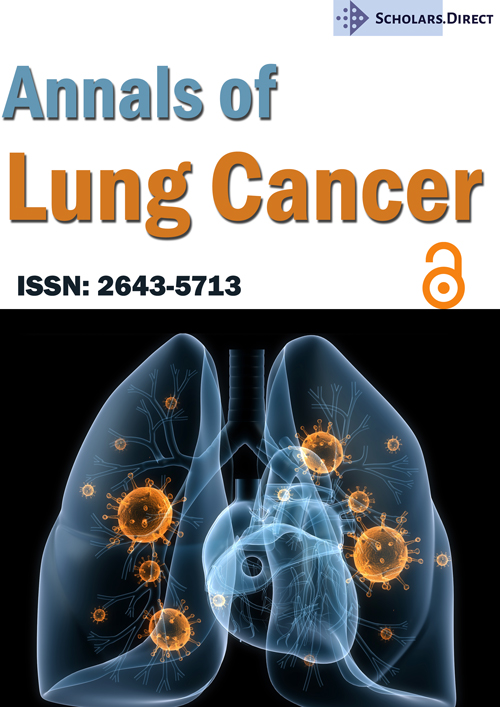Pembrolizumab in Non-Small Cell Lung Cancer: The Role of Restricted Mean Survival Time in Estimating The Long-Term Survival Benefit
Keywords
Kaplan-Meier estimate, Progression-free survival, Overall survival, Restricted mean survival time, Pembrolizuma
Abbreviations
RMST: Restricted Mean Survival Time; OS: Overall Survival; PFS: Progression-Free Survival
In comparison with the median, the restricted mean survival time (RMST) has a specific advantage because it examines the whole survival curve (like the hazard ratio) and expresses the survival outcomes using time as unit of measurement (like medians). More importantly, the RMST captures the presence of a long-term survival plateau indicating a better prognosis. Previous experiences on the application of RMST are mostly focused on oncology [1] but other fields are being investigated as well [2]. An original model-independent method of calculation, drawn from the field of pharmacokinetics, has markedly simplified the otherwise complex estimation of RMST [3,4].
In the present analysis, we assessed the RMST from the curves of long-term overall survival (OS) and progression-free survival (PFS) of the KEYNOTE-189 trial recently published by Gadgeel, et al. [5]. There were 410 and 206 patients in the pembrolizumab and placebo groups, respectively. Our analysis used the model-independent version of RMST [3,4]. The curves were truncated ("restricted") at 30 months for both PFS and OS. The 95% confidence intervals were estimated as previously described [6].
Table 1 shows the overall results of our analysis. The main finding is that, as regards OS, the survival gain of pembrolizumab estimated by RMST was approximately half the gain estimated by medians (5.42 vs 11.3 months per patient). This finding, which has an important clinical implications can be explained because, quite casually, the greatest distance between the two curves occurred at a residual survival of 50%, but thereafter the two curves got closer again with one another. This is a consequence of the punctiform nature of the median, whereas the RMST has the advantage to reflect the whole shape of the survival curve. Another factor that determines these differences is that the RMST captures the (favourable or unfavourable) trend of the right tail of the curves whereas, by definition, the median is not influenced by the right tails.
Irrespective of the cause of these differences, these results simply confirm that the RMST is more stable than the median. A growing evidence emerging from the literature confirms this conclusion along with purely theoretical considerations [1,2].
In summary, the literature on the RMST is by now extensive [7-9]. Particularly in the field of immunotherapy [7] and continues to grow. This report intends to question the role of gold standard that the median continues to play in oncology and elsewhere.
Funding
None.
Conflict of Interest
The authors declare no conflict of interests
References
- Trinquart L, Jacot J, Conner SC, et al. (2016) Comparison of treatment effects measured by the hazard ratio and by the ratio of restricted mean survival times in oncology randomized controlled trials. J Clin Oncol 34: 1813-1819.
- McCaw ZR, Yin G, Wei LJ (2019) Using the restricted mean survival time difference as an alternative to the hazard ratio for analyzing clinical cardiovascular studies. Circulation 140: 1366-1368.
- Damuzzo V, Agnoletto L, Leonardi L, et al. (2019) Analysis of survival curves: Statistical methods accounting for the presence of long-term survivors. Front Oncol 9: 453.
- Messori A, Damuzzo V, Agnoletto L et al. ( 2019) A model-independent method to determine restricted mean survival time in the analysis of survival curves. SN Comprehensive Clinical Medicine 2: 66-68.
- Gadgeel S, Rodrıguez-Abreu D, Speranza G, et al. (2020) Updated Analysis From KEYNOTE-189: Pembrolizumab or Placebo Plus Pemetrexed and Platinum for Previously Untreated Metastatic Nonsquamous Non–Small-Cell Lung Cancer. Journal of Clinical Oncology 14: 1505-1517.
- Messori A, Bartoli L, Damuzzo V, Chiumente M, Mengato D (2020) Restricted mean survival time estimated according to model-independent methods: procedure for calculating its 95%confidence interval. Open Science Framework, Published 25 March 2020. 10.17605/OSF.10/3A7UV, https://osf.io/qemhc/?
- Rahmadian AP, Delos Santos S, Parshad S, et al. (2020) Quantifying the survival benefits of oncology drugs with a focus on immunotherapy using restricted mean survival time. J Natl Compr Canc Netw 18: 278-285.
- Liang F, Zhang S, Wang Q, et al. (2018) Treatment effects measured by restricted mean survival time in trials of immune checkpoint inhibitors for cancer. Ann Oncol 29: 1320-1324.
- Kloecker DE, Davies MJ, Khunti K, et al. (2020) Uses and limitations of the restricted mean survival time: illustrative examples from cardiovascular outcomes and mortality trials in type 2 diabetes. Ann Intern Med 172: 541-552.
Corresponding Author
Andrea Messori, PharmD, HTA Unit, Regional Health Service, Via San Salvi 12, 50135-Firenze, Italy, Phone: +39-338-9513583, Email: andrea.messori.it@gmail.com
Copyright
© 2021 Messori A. This is an open-access article distributed under the terms of the Creative Commons Attribution License, which permits unrestricted use, distribution, and reproduction in any medium, provided the original author and source are credited.




